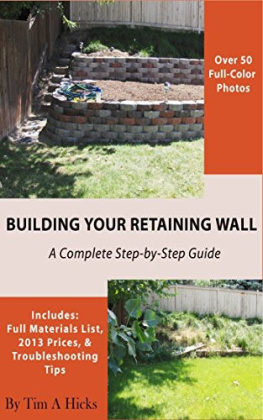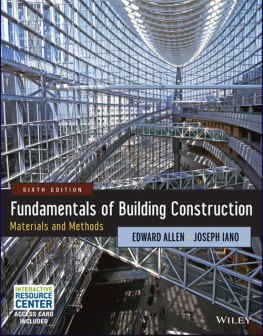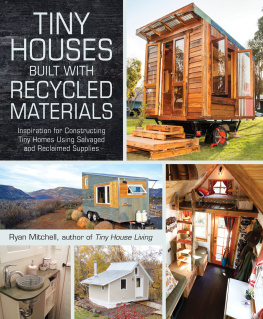
CONTENTS
Introduction
M illions of new structures are built across America every single year. Homes fill brand new housing developments, office buildings go up to serve corporate expansion, and even a few new barns are constructed. Meanwhile, hundreds of thousands of old buildings are razed. Other older structures are simply abandoned and left to the ravages of time. The cast-offs, the buildings being replaced or simply removed, are usually quickly demolished and sent to the nearest dump. But that truly is a waste. These buildings represent a fantastic opportunity to help the environment, save a little money, and incorporate one-of-kind design elements into your home.
Manyif not mostof the components that went into building structures that are ready to come down can be salvaged to find new life as reused home-design and building components. Using reclaimed building materials in new ways is part of a larger movement of sustainable building practices. In contrast to demolition, which sends tons of debris to land-fills, this environmentally friendly process is called deconstruction. Deconstruction is the craft of taking apart the structure to preserve every piece that can be reused, repurposed, or recycled. Its one aspect of environmentally friendly living. But the rewards of reclaiming building materials and reusing them in your home extend far beyond helping the environment. That just happens to be arguably the most important benefit.
AN EASY GREEN SOLUTION
Landfills are filling up quicker than we can find new places to put our building debris and other garbage. We produce more waste per person than any other country on the planet. Were also consuming materials at an alarming rate. Old growth forests have been overlogged for centuries, and now precious few are left. The U.S. Environmental Protection Agency estimates that we simply throw away more than a billion board feet of lumber each year. If we reused all of that we could save more than a million trees each year. Large deposits of high-quality quarry stones such as granite and marble are harder and harder to find. Theres simply no getting around that fact that many of the materials weve come to associate with quality in the home are either non-renewable or very slow to renew. And those resources continue to be depleted.
Diminishing natural resources are not the only environmental repercussions of our ongoing hunt for building materials. Finding, harvesting, and getting those materials to market means using vast amounts of energy. That translates to massive quantities of fossil fuels consumedand pollution createdin the process. Its a cold, hard fact that the buildings we erect tend to cost much more than we pay for them.
Fortunately, there are many solutions to the environmental issues raised in producing new building materials. Increasingly, builders and contractors are using synthetic and recycled alternatives, or extremely renewable resources such as bamboo. Home building and design are becoming more efficient, and other solutions will no doubt arise in the future. But a big answer to the issue of environmental impact and limited resources comes from the past. There is a treasure trove of usable materials in the buildings we tear down (or that fall down of their own accord). We just need to tap that resource.

Building debris accounts for much of the waste clogging landfillsmost of which could actually be put back into use.

These Douglas fir timbers were rescued from a building about to be demolished. Now theyll be repurposed as mantels, counters, or even support beams, providing unique beauty and a tremendous bargain for lucky homeowners.
LOWER COST, HIGHER QUALITY
Saving the environment could easily be a good enough justification to salvage and reuse building materials. But there are other great reasons as wellsaving a little money chief among them. The mini-industry that has sprung up to reclaim and resell used building materials competes with home centers and other retailers based largely on lower price and higher quality. Depending on whether youre shopping for heritage wood flooring or looking for a rescued slate slab for a countertop, you can expect to save from 10 to 50 percent off the price of comparable material sold brand new. In some instances, the owner of a building that must come down will let you take whatever you can safely remove, so the materials you salvage will cost nothing more than your labor.
Regardless of the source, you can expect to walk away with material that is as good or better quality than what you would pick up in the aisles of your local home center. Just about the only downside is that it may entail more research and work on your part, and much of what you find will not be in the standardized measurements common to building materials today.
Still, your wallet will thank you. And the money you save will be just part of your reward. Certain qualities and types of materialsespecially woodsare no longer available. Rare types of quarry stone, finely detailed architectural accents, and handcrafted leaded windows are just a sampling of the treasures that cant be matched on todays marketplace. In fact, much of the increasing popularity of reclaimed building materials is due to their unique nature and singular beauty. If youre in search of a one-of-a-kind look, reclaimed materials are a great place to start.
You may find rare species of woods not available, unusual stone surfaces with patterns and colors youre not likely to come across anywhere else, and glass that bears elegant imperfections from a less-standardized manufacturing process. Or maybe youre looking for something more modest, such as faucet or door handles that capture the charm of an earlier time, or wrought iron grillwork that can be repurposed as an eye-catching fence or bench.
Whatever the reclaimed material, small design projects are a great place to start reusing them. Although building an entire home or large structure from reclaimed materials takes a great deal of dedication and planning, and requires specialized expertise, the projects weve collected for this book can be completed by any homeowner with modest DIY skills and a basic set of tools. Weve purposely selected projects that are versatile and adaptable to any home. The techniques described here will provide a good base of skills and knowledge for working with any reclaimed materials, no matter what state theyre in or what you want to do with them. Start with these projects and eventually youll find even more ways to salvage and save.
GALLERY OF SALVAGED
BUILDING MATERIALS



















